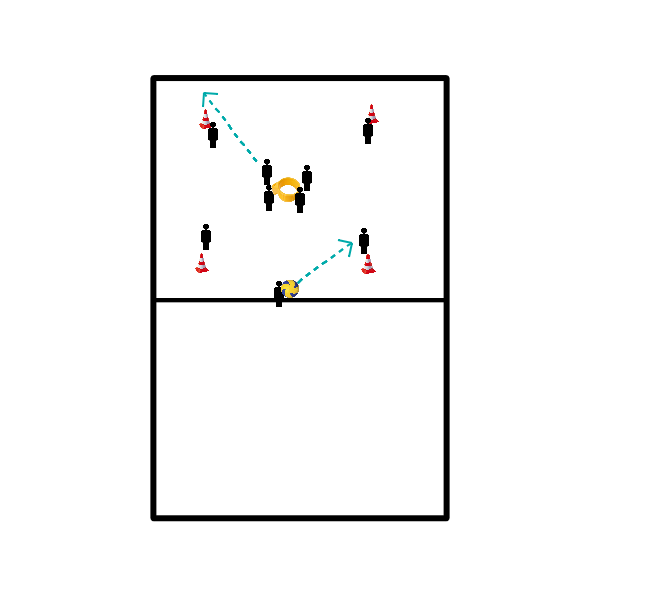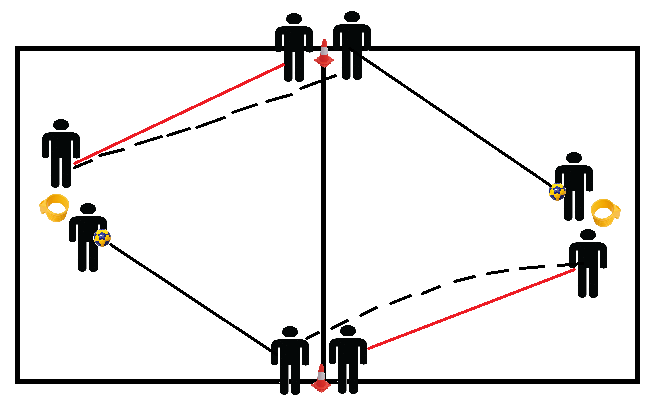Korfball drills for technique passing / attack
The exercise is performed with 3 or 4 players per basket. There is an attacker in front, a defender next to him or her, and a declarer and possibly a receiver under the basket. The ball is under the basket with the attacker, the exercise must be set up wide, so that the attacker has the space to perform the exercise. The defender is instructed to start at arm's length (can touch the attacker's shoulder). The attacker makes a wide move to the left or right, and receives the ball. The attacker plays the ball again to the attacker, and starts his action to the basket. The defender's task is to hold back the attacker with one hand, thus creating resistance for the attacker. The attacker will therefore have to continue to the basket, even if he gets resistance from the defender. At about 4 metres from the basket, the defender lets go and the attacker has to finish the ball. The attacker is not allowed to continue until a goal is scored, which makes him aware that he still has to complete the ball, despite the contact and a possible penalty throw.
Player 1 starts at 7 m, player 2 starts under the post.
Player 1 takes a pass but does not finish it. Instead, player 2 moves backwards away from the post, player 1 passes the ball to player 2 and player 2 shoots.
After this player 1 and 2 exchange roles.
Player 1 starts at 7 m in front of the post, player 2 signals 1-2 m in front of the post.
Player 1 takes the walkthrough and moves to 7 m behind the post. Player 2 catches the ball and passes at 1-2 m behind the post.
Player 1 takes a walkthrough ball from behind the post and catches his own ball, player 2 moves to 7 m in front of the post and repeats the exercise.
- 1 post, 1 ball, 4 hats in a square and 9 players
- The 4 attackers stand in a square (near the hats) around the post,
- the 4 defenders are holding the post with one hand.
- The 9th person (the declarer) stands with the ball outside the square of hats.
- The declarer brings the ball to one of the attackers, the defender facing the attacker who receives the ball has to run for the hat while the attackers now have to score as fast as possible.
- If all goes well, the attackers quickly find the free person because one of the defenders has to run around the hat.

- 4 vs 4
- Men come into a supportive position to let the ladies score.
- Option 1: Positions under the post are filled by 1 lady and 1 man.
- Option 2: Positions under the post would be filled by 2 men.
- Ladies would come out side by side, one for breakthrough and the other shoots.
- Mission of the defense is to play 1:1 pressure.
- 1 person under the pole.
- 2 persons in front of the post, attacker/defender.
- Ball is played out on the attacker who moves sideways.
- He receives the ball on the outer hand.
- The defender steps over and then the attacker takes the ball over and plays in.
- The attacker dodges and does the same again with the other hand.
- The attacker then dodges again and tries to shoot.
- The defender runs along but allows the pass and the shot to happen.
- Later on, the defender can choose whether to allow the pass or the shot.
- It is then up to the attacker to time well.
- Take care that players do not run into each other.
- This applies especially to younger teams.
- You make a box, with an attacker in it,
- the attacker must keep moving in the box, while a defender is following.
- The other player is standing outside the box.
- The attacker starts with the ball in his/her hands and throws it to someone on the side and the person on the side throws it back to the attacker and then throws it back to someone else standing on the side.
- The defender tries to take the ball.
- When the defender takes the ball, he throws it back you will try again
- The attacker always tries to run free and the defender tries to intercept the ball
- Per group: a post and a ball, the posts are preferably (but not absolutely necessary) arranged in a circle or rectangle.
- The number of persons per group is less important (but all groups are about the same size).
- The first task for the groups is to score 10 goals with a through-ball.
- When you have finished with that, the person who scored the last goal runs to the trainer to get the next task. Which group performed all the tasks first?
- The trainer has a piece of paper with tasks on him.
- When someone comes to get the next task, first ask which task has just been completed (this can vary considerably over time) and then give the next task.
- List:
- 5 through-balls,
- 5 penalty throws,
- Five 3-meter shots,
- 5 shots from 3 meters behind the post.
Create a box with an attacker inside.
- The attacker has to keep moving in the box while a defender is running.
- Someone always plays the ball.
- The defender looks at the ball and tries to catch it
- Every time the attacker catches the ball, someone enters the box.
- When the defender picks up the ball, he throws it back and tries again
- The ball is thrown in a circle.
- A child starts behind the person standing next to the person with the ball.
- The ball must be overtaken.
- The rest has to make sure that the ball is thrown over.
- Place two posts where they usually are during a game.
- Then place two pilons at the far left and far right on the center line.
- Ideally, this exercise is done with 8 people, more is possible, less than 8 doesn't work.
- At each post or pilon two people are standing, one person under the post starts with the ball (on both sides).
- This person throws the ball to someone near the pilon on his right and runs after the ball.
- This person then throws the ball to the other post, and the second person near the pilon goes for a through-ball.
- Now the ball is under the post again and the round starts over again.
Arrangement:
(Black line: throwing and running after the ball) (Black dotted line: throwing ball) (Red line is running for a through-ball)
- 4 posts and 4 groups,
- 2 Balls: aim to think how to run freely when building up.
- 4 versus 4 with 2 posts:
- trying to throw a long ball when building up by running deep,
- running free through tempo change.
- Pause a few times to discuss running free and tempo changes;
- learning to find an angle,
- or when the angle is fixed, the long diagonal throw.
- 2 posts and 3 groups,
- defending party intercepts,
- builds up and goes on to attack the box;
- Build up starts in defence!








